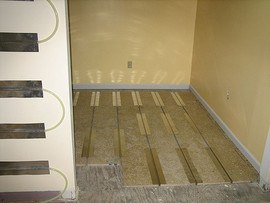How Much Does Polyester Carpet Cost?
Carpeting is popular in bedrooms, family rooms, basements, and children’s playrooms. It comes in many colors, fibers, and styles and is often soft and warm. For those who want a fairly durable carpet that is water and stain-resistant while remaining soft to the touch, polyester carpeting makes a good choice.
Polyester carpets fall into several categories. Older polyester carpets are stain-resistant, soft, and inexpensive. Newer polyester carpets are made from recycled materials, such as water bottles, making them a more costly but greener solution that is soft and stain-resistant. Polyester can be found in most types of carpeting and a range of colors, including bold colors that are difficult to find in other fibers.
The national average cost of polyester carpeting is $800 to $1,200, with most people paying around $950 for 200 sq.ft. of PET polyester in a Saxony carpet. This project’s low cost is $600 for 200 sq.ft. of basic polyester in a Berber-style carpet. The high cost is $1,400 for 200 sq.ft. of PET polyester in a plush-style carpet with a pattern.
Polyester Carpet Cost Calculator
Like most materials, polyester carpets come in different quality levels, which can impact durability and cost. Below are the average costs for 200 sq.ft. of polyester carpeting.
|
Polyester Carpet Costs
|
|||
|---|---|---|---|
| Basic | Standard | Best Quality | |
| Polyester Carpet Cost (Material Only) | $300 - $500 | $600 - $800 | $800 - $1,200 |
| Polyester Carpet Installation Cost (Labor Only) | $150 - $200 | $200 - $250 | $300 - $400 |
| Total Costs | $450 - $700 | $800 - $1,050 | $1,100 - $1,600 |
| Polyester Carpet Cost per Sq.Ft. | $2.25 - $3.50 | $4.00 - $5.25 | $5.50 - $8.00 |
Polyester carpets are made from plastic, meaning they are moisture-resistant and can be spun in various ways to create soft carpet fibers in several styles. Polyester is solution-dyed, meaning it can be found in many bright colors. It can also be stain-resistant.
Basic polyester carpets are made out of older polyester formulas from the 1970s. They are soft, colorful, and inexpensive but not highly durable. They make a good choice for basements and children’s playrooms.
Newer polyester carpets are made of PET (polyethylene 1 terephthalate) polyester. This material is made from recycled plastic, such as water bottles. It is much greener and a good insulator. It can also produce thicker carpets, with slightly better quality. Most better-quality polyester carpets are made of PET polyester, with a few being made of PTT polyester - a cousin of triexta carpets. These are most likely found in longer fibers like shag carpets and carpets with varying patterns.
No matter how good the quality, polyester is not as good as nylon or triexta for heavy wear. It can crush and does not hold up as long as other fibers.
Additional Considerations and Costs
- Maintenance. Polyester carpets are fairly easy to maintain. They are moisture and stain-resistant, but they can soil. Vacuum regularly to remove soil marks.
- Handmade polyester carpet. Polyester fibers can be woven, but this material is almost always machine-made. If you like handmade carpets and want polyester, look for broadloom carpets.
- Moisture. Polyester is moisture-resistant because of its chemical makeup and how it is dyed. It can be used in damp areas like basements.
- Durability. Polyester has moderate durability. It is not as durable as nylon or triexta but far more than olefin. It is a good choice for moderate-traffic areas.
- Radiant flooring. You can install radiant floor heating 2 beneath your polyester carpeting. Polyester is good at insulating, so you may need to increase the heat. Radiant heating costs between $10 and $25 a square foot.
- Sustainability. Newer PET polyesters are made from recycled water bottles and other recycled plastics, making them greener than some carpets. The material cannot be recycled again, however.
- Material improvement. Polyester was first introduced in the 1970s. While some polyester carpets are made with the same material, newer innovations have improved them, making them more durable and softer.
- Crushability. Polyester can crush and does not bounce back as easily as some fibers. Heavy furniture and high-traffic areas can see crushing.
FAQs
- How long do polyester carpets last?
Polyester carpets typically last between 5 and 10 years. PET polyester tends to last longer than the basic types.
- Is polyester carpet better than nylon?
Nylon is the better material. It is more durable and lasts longer. However, polyester is moisture-resistant, making it the better choice for basements.
- Is polyester carpet good for pets?
Polyester is stain-resistant and does not absorb liquids like urine, making it a good choice for pets.
- Is polyester carpet good for a bedroom?
Polyester is warm and soft, making it a good choice for bedrooms.
Remodeling Terms Cheat Sheet
Definitions in laymen's terms, cost considerations, pictures and things you need to know.See full cheat sheet.
 2 Radiant floor heating: (Also known as Radiant floor) A heating system using tubes or electric wires installed underneath the flooring
2 Radiant floor heating: (Also known as Radiant floor) A heating system using tubes or electric wires installed underneath the flooring
How much does it cost to install polyester carpet in my city?
Cost to install polyester carpet varies greatly by region (and even by zip code). To get free estimates from local contractors, please indicate yours.

